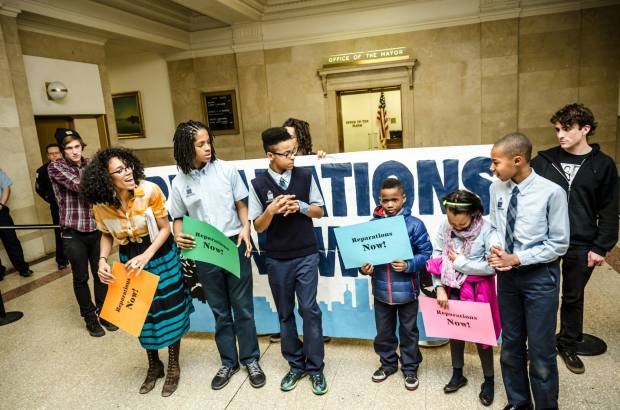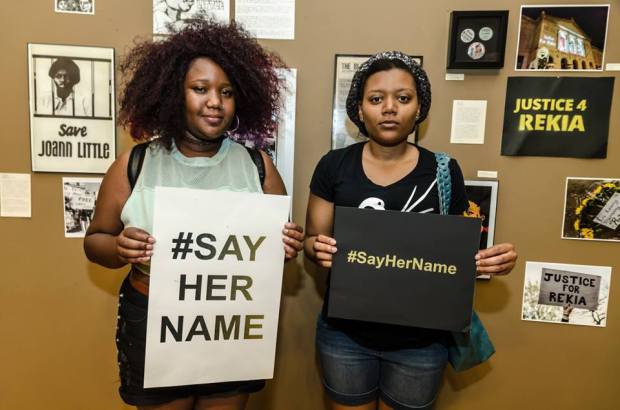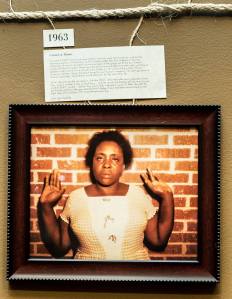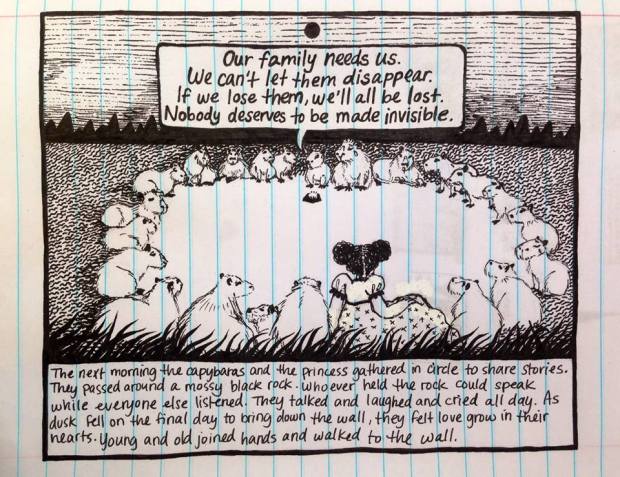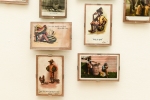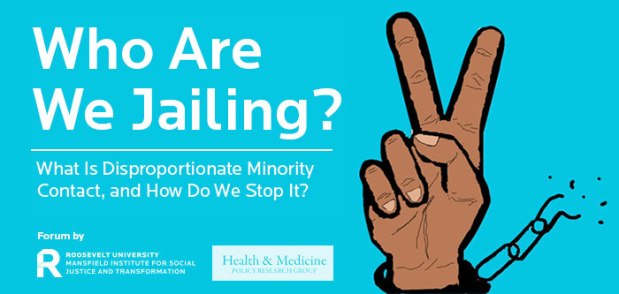In April, we screened the “End of The Nightstick,” a film that documents the torture inflicted upon over 118 Black men and women by police Commander John Burge and his fellow officers from 1972 to 1991. It begins with a memorable quote from Alexander “Clubber” Williams, an N.Y.P.D. Lieutenant, in 1877.
“There is more law in the end of a policeman’s nightstick than in a decision of the Supreme Court.”
Chicago’s legacy of police violence runs deep, and persists today. We at Project NIA have worked to resist state violence and to advocate for both the living and the dead.
This year, Project NIA joined with Chicago Torture Justice Memorials, We Charge Genocide and Amnesty International to co-lead an intensive six-month-long organizing campaign, #RahmRepNow, to pass a reparations ordinance for survivors of torture under Burge. And on May 6, 2015, we won. This victory was a long time in coming and built upon decades of previous organizing. It is the first time that any municipality in the U.S. will provide reparations to those harmed by law enforcement violence!
The #RahmRepNOW campaign was supported by several other groups and individuals who contributed their time, talent, and much more. These included the Chicago Light Brigade, BYP 100, Elephant Rebellion, Kuumba Lynx and others.
A sample of actions and events can be seen in this short video that we produced as part of the campaign.
We are so proud of what we accomplished together here in Chicago. In 2015, our work to address police violence was anchored by our successful fight for reparations for torture survivors. We also worked in various ways with many co-strugglers to raise awareness and organize against law enforcement violence, including co-organizing a conference attended by over 350 people in January and a teach-in this December about the new pattern and practice investigation by the U.S. Department of Justice into the Chicago Police Department precipitated by the murder of 17-year-old Laquan McDonald by Officer Jason Van Dyke.
Throughout the year, we focused on the ways that police violence, of which the Burge case is an egregious example, impacts Black women and girls in particular. We also continued to center the experiences of youth in conflict with the law. Below, read about our year of work centering these two topics, and their nuances and intersections.
Black Women and Girls
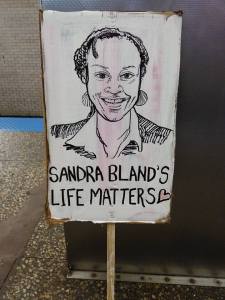 Cis and trans Black women and girls are major targets for police brutality and criminalization. Black girls in particular are the fastest growing population in the juvenile legal system, and are suspended, expelled, and arrested from school at a higher rate than their peers. In October, Project NIA, Lifted Voices, and The Chicago Light Brigade joined students at Rudy Lozano Leadership Academy to share radical art and discuss the school-to-prison pipeline that increasingly impacts Black girls in Doing the Math: Resisting High School Pushout.
Cis and trans Black women and girls are major targets for police brutality and criminalization. Black girls in particular are the fastest growing population in the juvenile legal system, and are suspended, expelled, and arrested from school at a higher rate than their peers. In October, Project NIA, Lifted Voices, and The Chicago Light Brigade joined students at Rudy Lozano Leadership Academy to share radical art and discuss the school-to-prison pipeline that increasingly impacts Black girls in Doing the Math: Resisting High School Pushout.
In recent years, we’ve seen the stories of a few Black women who have suffered horribly at the hands of the law come to light, such as Rekia Boyd, murdered by off-duty Chicago police detective Dante Servin, and Sandra Bland, who died in a Texas jail after a bogus traffic stop and violent arrest.
In 2015, Project NIA focused on women like Rekia and Sandra, hosting numerous events and exhibitions with allied organizations aimed at lifting up their stories and experience with prisons, police, and their safety, or lack thereof. In July, we partnered with our friends at the Chicago Light Brigade to co-organize an action in support of Sandra Bland’s friends and family. The Chicago Tribune produced a beautiful short video of the event.
Following the unjust acquittal of Dante Servin, Project NIA, and allied organizations reclaimed August as Black August—Women and State Violence, hosting events including Killing Black Women: Race, Gender, and Capital Punishment and Criminalizing Black Girls: A Workshop. In these spaces, we considered how and why Black women and girls (trans and non-trans) are targeted, what are the effects of this disproportionate criminalization, and how we can interrupt the cycle of state violence.
Showing up, showing love, and showing solidarity takes a large emotional toll on our community. In 2015, we helped catalyze community building around the lives of Black women and girls, as well as resistance and education. In October, for example, a group of people gathered for a potluck closing event for the Blood At the Root: Unearthing Stories of State Violence Against Black Women and Girls Exhibit at Holy Covenant Church in Lakeview.
Check out these pieces from the exhibit highlighting Black women criminalized over the years. What do you see? We see women who fought back against violence, survivors, visionaries, and those who remind us of our mothers and sisters.
While perusing the exhibit (as seen above) before closure, people were encouraged to write letters and cards of love and encouragement to incarcerated Black women. The story Niya Kenny, a young Black student who was arrested for standing up for her fellow classmate, a young Black girl brutalized by a police officer in their classroom, was also a topic of letter-writing.
Criminalized and Incarcerated Children
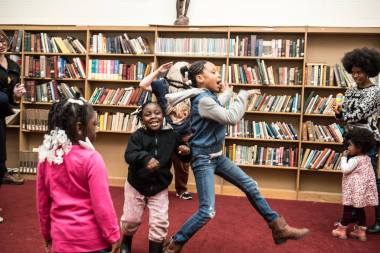 Black children are too often denied the chance to learn, grow, and simply play and enjoy their childhoods free of the danger of violence. Every year, Project NIA dedicates a significant portion of our work to advocacy for children in the system, and those who are victims of state violence.
Black children are too often denied the chance to learn, grow, and simply play and enjoy their childhoods free of the danger of violence. Every year, Project NIA dedicates a significant portion of our work to advocacy for children in the system, and those who are victims of state violence.
This year was no different. On November 22, 2015, it was the one-year anniversary of 12-year-old Tamir Rice’s death. He was killed by Cleveland Police Officers Timothy Loehmann and Frank Garmback playing outside of a youth center. So on November 23, 2015, Black Lives Matter:Chicago, the Chicago Childcare Collective, and Project NIA joined forces to celebrate the precious life taken from us through a “play-in”— where children and youth PLAYED group games, made art, and created cards for Tamir’s family and more. By gathering community to play without fear, we refused to allow Black children to be robbed of their childhoods and their right to have fun.
Another way that the state harms Black children is through incarceration. To increase public awareness of the destructive impact of the juvenile justice system on children, we facilitated a workshop, Understanding the Illinois Juvenile Justice System: the Basics. Community members, parents, educators, young people, and organizers were trained to identify the resources and rights that youth have in and outside of the system, some issues that young people in contact with the law face, and more.
We didn’t stop at teaching about the juvenile justice system. We continued to provide direct support and advocacy for young people in conflict with the law. We also reached out to Chicago’s incarcerated children and those impacted by the incarceration of family members.
As part of this year’s National Week of Action Against Incarcerating Youth Bobby Biedrzycki, writer, artist, and educator, led a an interactive session where participants wrote letters, poems, and prose to incarcerated children. These beautiful notes will be compiled into a zine mailed to children incarcerated in Illinois youth prisons as part of a project that we catalyzed this year called Liberation Library. Liberation Library provides books to youth in prison to encourage imagination, self-determination and connection to the outside worlds of their choosing. Book donations are always needed. Find the list here.
As we continue to fight for incarcerated children, we also need to consider how to talk to children about their incarcerated loved ones. We strongly believe that art, like the zines mentioned above, are a powerful tool for reimagining what our community health and safety can look like outside of relying on systems like the Prison Industrial Complex. Chicago-born artist, and our former intern, Bianca Diaz explores new ways to talk about incarceration through a beautiful children’s book titled The Princess Who Went Quiet, which she wrote and illustrated. The Princess Who Went Quiet serves as a visual entry point to address how to talk to kids about incarceration.
Young People in Chicago Resist Criminalization
Young people in Chicago are organizing hard and consistently against police violence and criminalization—many of them queer, black women.
With all that our community has accomplished this year, Project NIA with Tom Callahan produced a visual love note to our fellow activists and organizers who spent all year in righteous struggle to end police violence:
An important way that we tangibly contributed to the development of young Chicagoans this year was by piloting along with the Chicago Freedom School a new program called “Young Leaders for Justice (YLJ). YLJ was an opportunity to support young people ages 17 to 24 to develop their knowledge about criminalization and to learn organizing skills. Over eight sessions spanning four months, participants learned about the dynamics and nature of the prison industrial complex, oppressive policing, the juvenile justice system, healing justice, using social media as a tool for organizing, and more. In the final couple of sessions, participants learned about strategies for grassroots fundraising and embarked on a historical walking tour of Chicago.
Understanding that many of Chicago’s young organizers are actively inspired by Assata Shakur’s life and legacy, we also co-organized a well-attended teach-in in May to connect our current historical moment with Assata’s resistance as a Black woman and member of the Black Panther Party.
In a letter to the members of the Hands Off Assata Campaign who were organizing actions in honor of her 60th birthday (in 2007), Assata wrote:
“I am 60 years and it is doubtful that I will ever live to see my people free of oppression and repression. But I am totally convinced that our collective dream of freedom will some day be realized.”
Let us be inspired and heartened by Assata’s words. We are so proud of what we have built in 2015. Let’s keep rising in love and solidarity with one another to work towards our collective freedom.
*Exhibition Highlight 2015*
Over the past few years, Project NIA has documented the ways that oppression and criminalization impact specific groups (particularly Black people). One of the ways that we’ve done so is through creating exhibitions that bring together thousands of people across Chicago to learn about and address these issues. This fall, we co-curated a new exhibition titled: Making Niggers: Demonizing and Distorting Blackness Through Racist Postcards and Images
From the 1890’s through the 1950’s, thousands of postcards depicting racist caricatures and stereotypes of Black people were produced across the United States and the world. In our exhibition, Making Niggers: Demonizing and Distorting Blackness Through Racist Postcards and Images, we asked:
How did white people justify their continued subordination of Black people post emancipation?
Our exhibition illuminates the racist attitudes and ideologies that were/are endemic to U.S. culture and society. Relying primarily on postcards from co-curator Mariame Kaba’s collection, this exhibition speaks to the legacy of anti-Black racism that still structures our present. The racist images underscore the ‘routine’ denigration of Black people. They illustrate how little Black lives have mattered in this country. They belie the need for a hashtag and a movement affirming that #BlackLivesMatter.
Get your photo gallery fix here. The exhibition ends at the end of January 2016. Find visiting information and more at the website.
Research and Curriculum Development
This year, we continued to host discussions about the importance and uses of data, and to analyze/summarize relevant juvenile justice-related information. You can find two recent reports about juvenile and school-based arrests here and here. Our work and research continued to be cited in the press this year.
We also held true to our mission of educating as many people as possible about the impact and effects of the carceral state by developing and sharing (free) curriculum resources like Teaching about the Prison Industrial Complex and Criminal Legal System: Exercises, Simulations, Resources, and Discussion Ideas. To date, over 500 copies of the curriculum have been distributed at no cost. Thousands of people around the world rely on our resources.
Thank You
We would like to thank all of our donors, volunteers and partners for their contributions to our work this year. Without you, nothing that you read about in this end of year summary would be possible. Project NIA is a volunteer-driven organization that operates on a very lean budget. But we do a lot with a little. If you would like, you can continue to support our work by making a financial contribution today.
Happy holidays and see you in 2016!
